A car’s bodywork may be beautiful, the underbody shouldn’t be ignored. Even if the car is shining with polish, the underbody could still be irreparably lost. A corroded underbody is a knock-out criterion at MOT inspection. The only thing offering enduring protection against corrosion damage to the wheel covers, sills and underbody are coating of cavities and underseal. Unfortunately neither measures offer a permanent solution and periodically checking, especially in old cars, is essential. This guide is about the underseal (Am: undercoating), and it will tell you everything you need to know about professional sealing for corrosion prevention.
Unacceptable combination
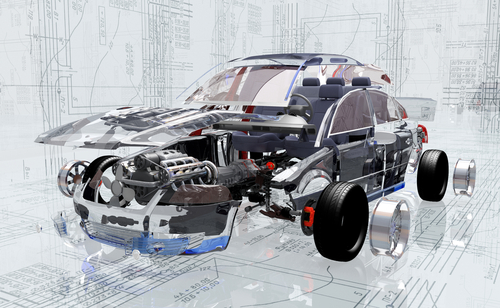 Cars still consist mostly of steel panels. No other material offers the same favourable proportions of cold formability and sturdiness and a reasonable price. The main disadvantage of steel panels is their high content of iron. Through contact with moisture – and in the worst case – road salt, iron starts to rust. If this is not duly noticed and removed, rust will gradually spread.
Cars still consist mostly of steel panels. No other material offers the same favourable proportions of cold formability and sturdiness and a reasonable price. The main disadvantage of steel panels is their high content of iron. Through contact with moisture – and in the worst case – road salt, iron starts to rust. If this is not duly noticed and removed, rust will gradually spread.
Underseal helps – but not permanently
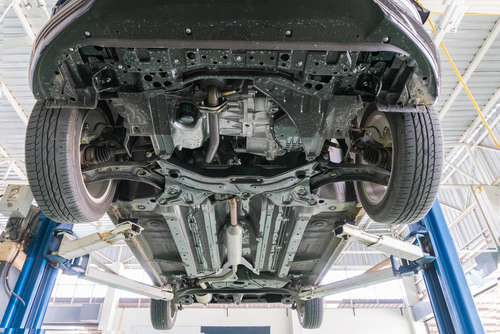 Underseal is a protective paste, often containing bitumen, excellently suitable for sealing the underbody. Nowadays, new cars are given a protective layer at construction, lasting several years. Underseal is applied in a ½ millimetre layer. The rubbery substance fills holes caused by grit and does not scratch. Over time, underseal tends to dry out. After a period of 8 years at most, the protective layer should therefore be thoroughly inspected. If there are fissures or if the layer is flaking, immediate action is necessary.
Underseal is a protective paste, often containing bitumen, excellently suitable for sealing the underbody. Nowadays, new cars are given a protective layer at construction, lasting several years. Underseal is applied in a ½ millimetre layer. The rubbery substance fills holes caused by grit and does not scratch. Over time, underseal tends to dry out. After a period of 8 years at most, the protective layer should therefore be thoroughly inspected. If there are fissures or if the layer is flaking, immediate action is necessary.
The pitfall called old underseal
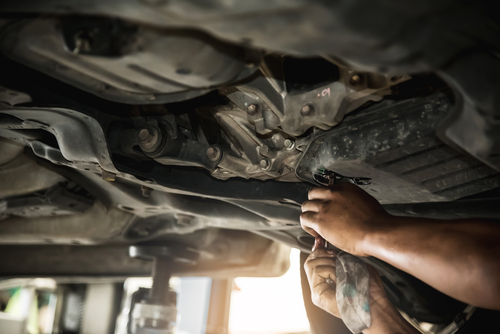 Sometimes, moisture is sealed in an old layer of underseal. If salty water gets trapped between the protective layer and the sheet metal, it cannot escape. Water, remaining on steel generates corrosion. In this case, old underseal creates the opposite of its original goal – instead of protecting against corrosion, it stimulates the formation of rust.
Sometimes, moisture is sealed in an old layer of underseal. If salty water gets trapped between the protective layer and the sheet metal, it cannot escape. Water, remaining on steel generates corrosion. In this case, old underseal creates the opposite of its original goal – instead of protecting against corrosion, it stimulates the formation of rust.
Applying and improving the underseal
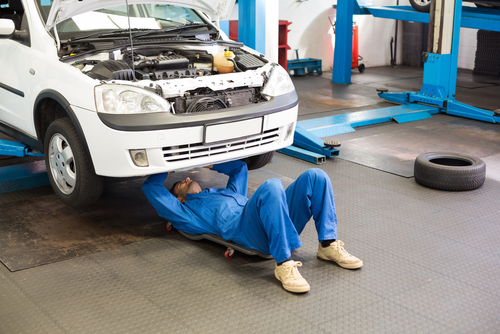 Therefore, spraying a dinitrol or tectyl layer on an old layer of underseal doesn’t really help. For a permanent protection of the underbody of the car against corrosion, the old sealant layer should be removed. The bad news is, that this is either difficult or expensive. The good news is, that only the seriously damaged spots need treatment. These are generally the edges of the sills or the wheel arches. The surface sealing the centre of the underbody often remains unaffected during the entire life span of the car.
Therefore, spraying a dinitrol or tectyl layer on an old layer of underseal doesn’t really help. For a permanent protection of the underbody of the car against corrosion, the old sealant layer should be removed. The bad news is, that this is either difficult or expensive. The good news is, that only the seriously damaged spots need treatment. These are generally the edges of the sills or the wheel arches. The surface sealing the centre of the underbody often remains unaffected during the entire life span of the car.
Underseal removal procedure
For removal of underseal three methods are applicable:
1. Manual removal with scraper blade and steel brush
2. Burning off
3. Blasting
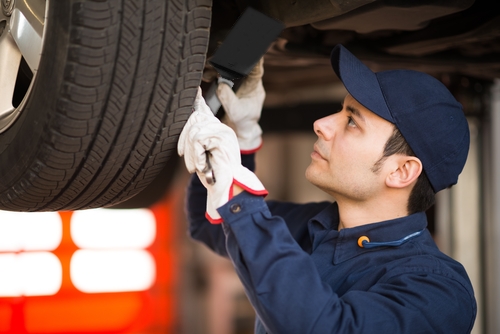 The manual removal with a scraper and a brush is very cumbersome and particularly suitable for removing loose rust at spots where holes are visible. Using machinery is of little use here. The viscous bitumen will very quickly cause rotating brushes and sandpaper to clog. Steady manual work is the best option. A heat gun can considerably simplify the job, especially on spots which are difficult to reach. The manual removal with a scraper and a brush is very cumbersome and particularly suitable for removing loose rust at spots where holes are visible. Using machinery is of little use here. The viscous bitumen will very quickly cause rotating brushes and sandpaper to clog. Steady manual work is the best option. A heat gun can considerably simplify the job, especially on spots which are difficult to reach.
|
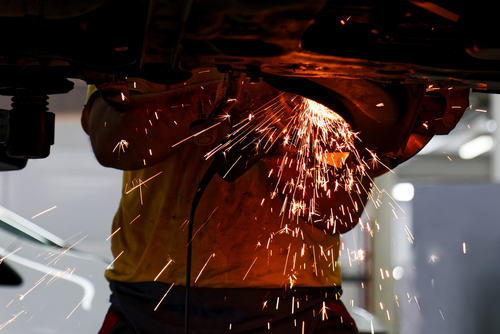 Burning off is a habit of hard-core DIY’ers. We strongly advise against playing with fire. Before you know you burn down your car and consequently your whole garage. Burning off is a habit of hard-core DIY’ers. We strongly advise against playing with fire. Before you know you burn down your car and consequently your whole garage.
|
Finally, blasting is a popular method for the removal of underseal. There are two principally different methods: the abrasive and the non-abrasive method.
|
Removal of rust
Prior to application of new underseal, some preparative work is necessary, mainly the total removal of remaining rust. A scraper blade and a brush are most effective, although this removes only the loose, superficial rust. An angle grinder enables you to work in the depth, although you risk grinding off healthy material as well. We therefore recommend the use of rust converter. The substance is applied with a paint brush and should be allowed to soak in. When the red rust has turned into a black greasy mass, you can simply remove it with a cloth. Apparently, the welding of rust holes should always be left to a professional service provider.
Very important: de-greasing and taping off
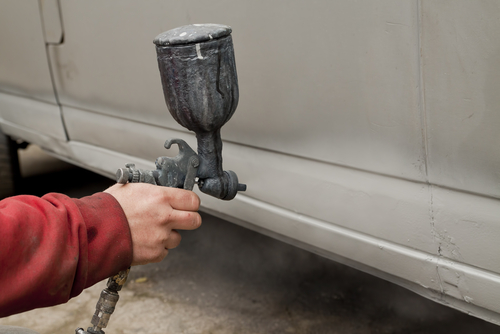 Underseal requires the same as painting of metal: the surface should be de-greased first. Silicon cleaner has proved to be the most suitable substance. Apply a covering layer and remove it after letting it take effect. Afterwards the bodywork should not be touched with other substances. Spraying with WD-40 or penetrating oil is not allowed. Otherwise you can start the degreasing procedure all over again.
Underseal requires the same as painting of metal: the surface should be de-greased first. Silicon cleaner has proved to be the most suitable substance. Apply a covering layer and remove it after letting it take effect. Afterwards the bodywork should not be touched with other substances. Spraying with WD-40 or penetrating oil is not allowed. Otherwise you can start the degreasing procedure all over again.
All moving and hot components should NOT be treated with underseal. Therefore it is recommended to tape off the steering mechanism and the exhaust with newspaper. The steering mechanism could be hampered in its movement by the undersealant. On the exhaust, the substance causes a danger of fire. Therefore take care that nothing can happen here! Tape of the exterior of the sill halfway. This area needs undersealing as well.
New underseal
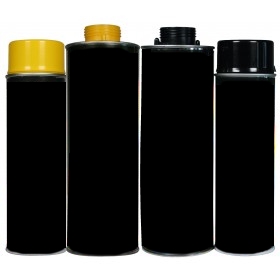 After blasting or grinding the underbody down to the naked panelling, sealing it with spray primer is recommended. This will allow the underseal to adhere properly. Just spray on the primer and allow it to dry.
After blasting or grinding the underbody down to the naked panelling, sealing it with spray primer is recommended. This will allow the underseal to adhere properly. Just spray on the primer and allow it to dry.
Underseal is nowadays available in spray cans and should be sprayed onto the metal in a 0.5 mm layer. Applying too much is in this case advised against. A thicker protective layer means nothing but a waste of substance. The new protective layer should be allowed to dry for 4 hours. Afterwards the taping can be removed. The exterior of the sill can now be painted in the colour of the car. Underseal can be painted over after hardening.
Foto: Minerva Studio, Mark_KA, Ronald Sumners, santol, wavebreakmedia, eggeegg, iurii, Marijus Auruskevicius / shutterstock.com

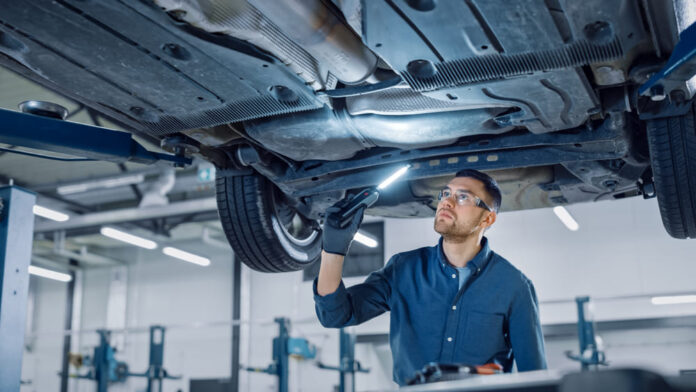
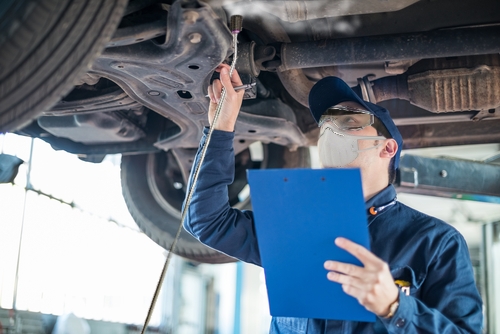 For abrasive blasting, granular material is propelled against the underbody of the car with help of pressurised air. The most familiar method is sand-blasting, although there are several other possible blasting media: baking soda, glass, plastic pellets, nutshells and many more. The advantage of abrasive blasting is its guaranteed success. The protective layer is quickly and thoroughly removed from the underbody and very cheaply at that. Its disadvantage is the amount of waste it produces. Furthermore, due to too high pressure or the wrong blasting medium a healthy underbody panelling might sustain damage.
For abrasive blasting, granular material is propelled against the underbody of the car with help of pressurised air. The most familiar method is sand-blasting, although there are several other possible blasting media: baking soda, glass, plastic pellets, nutshells and many more. The advantage of abrasive blasting is its guaranteed success. The protective layer is quickly and thoroughly removed from the underbody and very cheaply at that. Its disadvantage is the amount of waste it produces. Furthermore, due to too high pressure or the wrong blasting medium a healthy underbody panelling might sustain damage.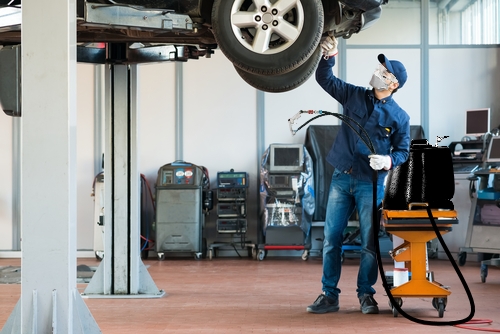 Non-abrasive blasting methods are an effective alternative: instead of hard blasting material, dry ice-blasting uses frozen carbon dioxide pellets, bursting at impact on the protective layer, reliably removing it. Save from the old protective layer, dry ice-blasting produces no waste and is absolutely safe for the underbody. Another alternative is high-pressure water-blasting. The disadvantage of these otherwise very effective methods is their price. Renting a dry ice-blasting device costs ca. 100 – 300 euro (£175 – £265) per day. This method is therefore particularly suitable for high-grade cars such as luxury sports cars or vintage cars. Dry ice-blasting by a professional service provide could set you back 500 – 1000 euro (£440 – £880).
Non-abrasive blasting methods are an effective alternative: instead of hard blasting material, dry ice-blasting uses frozen carbon dioxide pellets, bursting at impact on the protective layer, reliably removing it. Save from the old protective layer, dry ice-blasting produces no waste and is absolutely safe for the underbody. Another alternative is high-pressure water-blasting. The disadvantage of these otherwise very effective methods is their price. Renting a dry ice-blasting device costs ca. 100 – 300 euro (£175 – £265) per day. This method is therefore particularly suitable for high-grade cars such as luxury sports cars or vintage cars. Dry ice-blasting by a professional service provide could set you back 500 – 1000 euro (£440 – £880).
 (14 votes, average: 4.00 out of 5)
(14 votes, average: 4.00 out of 5)







